
Woke up this morning to the startling news that the Geneva team has added an Msin(i)=1.9 Earth mass planet to the Gliese 581 system! The preprint (Mayor et al. 2009) is available from exoplanet.eu, and will appear in Astronomy and Astrophysics. With a radial velocity half-amplitude, K=1.85 m/s, Gl 581e is the lowest-mass planet detected to date.
“The orbital period of the new planet “e” is quite close to pi days. i would mark down a score of -1 for competing planet hunters, whose signals-to-noise are accumulating in proportion to the root of the number of measurements.” said Greg Laughlin, an astronomer at the University of California, Santa Cruz.
In addition to the detection of the new 1.9 Earth-mass planet in the system, the period of Gliese 581d has been revised (to great habitability fanfare) from 84 days to 66 days. Indeed, the new, shorter period raises the habitability value of Gliese 581d from about 0.5 cents to nearly one penny.
As often happens, a strong hint of the new planet was lurking unnoticed in the previously published radial velocity data, and it’s especially interesting to look at the details in this particular case to see how the period revision came about. Let’s work with the 50 radial velocities published by Udry et al. 2007.
The two strongest periodicities in the system come from planets b and c. Removing these planets with the assumption of circular orbits leaves a residuals periodogram that has its strongest peak at 84 days:
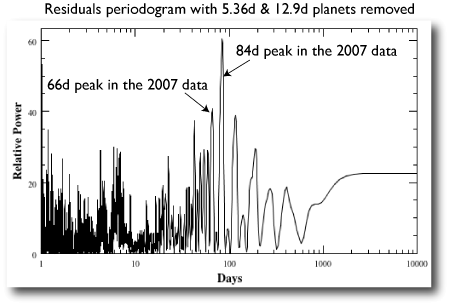
The 66 day periodicity is lagging in second place with 66% of the power. Nevertheless, both periodicities provide significant improvement to the fit. An 84-day planet has K=2.67 m/s, and leaves an RMS of 1.43 m/s to the three planet fit:
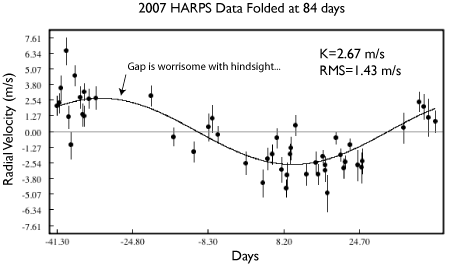
A best fit 66-day planet has a slightly higher K=2.77 m/s, but leaves an RMS of 1.72 m/s. The chi-square is also higher: 5.10 as compared to 3.65. In the 2007 data, the 84-d planet thus looked quite secure. With hindsight, though, one notices that the phase coverage in the 66-day fit is better than for the 84-day fit. As more data was obtained, it became clear that the 84-day period was an alias of the true 66-day periodicity. Fair enough — RVs are expensive to obtain, and revisions of this sort are an inevitable product of progress.
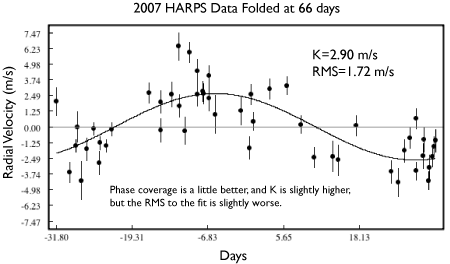
In the residuals to the fit with the 84-day planet, planet e is present, but it’s masked by a spurious periodicity at 3.45 days,
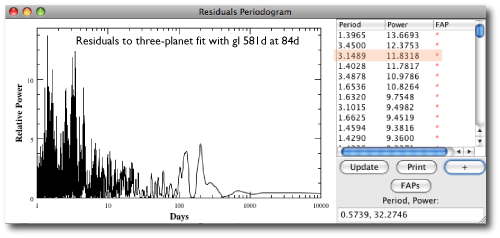
whereas in the residuals to the fit with the 66-day planet, planet-e is in the #1 spot — not yet significant, but certainly more tantalizing…
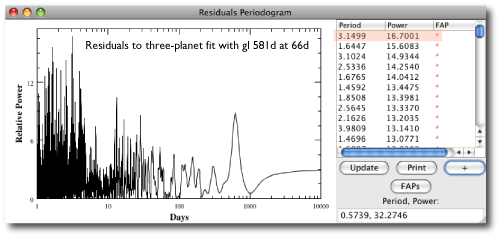

Could the 66 day data be hiding two planets in a 2:1 resonance?
That’s certainly a possibility, but one would need to get a substantially larger number of RVs to verify and characterize such a configuration.
There’s now a very interesting gap between the 12.9 and 66d planets. Could easily fit a million-dollar+ world in there, and I’m sure that fact is not lost on the Geneva team…
Can astrometry refine the inclination of this system, or are the planets too small to pull the star far enough to measure?
The biggest astrometric wobble would be due to the
outer most planet, and I estimate that the amplitude of the wobble should be less than 5 micro arc seconds (based on the dynamical constraints discussed in the paper). I think Gaia may be the first satellite (I believe it’s scheduled to launch in 2013) that will have the astrometric precision to reliably measure such a small astrometric wobble.